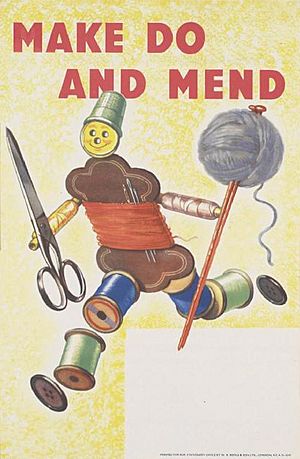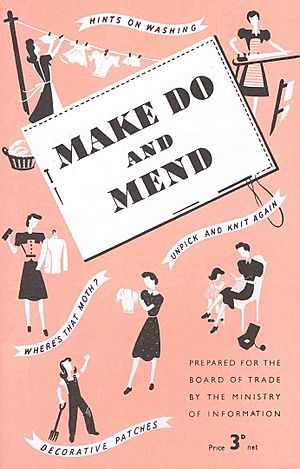Make Do and Mend facts for kids
Make Do and Mend was a special program in Britain during World War II. The British government started it with help from groups like the Women's Institute. Its main goal was to help people use less new clothing. This saved important materials and resources for the war effort.
The program taught people how to take care of, change, and fix their clothes. They made helpful booklets with instructions. They also worked with volunteer groups to offer classes. These classes taught skills like dressmaking and other crafts.
Why "Make Do and Mend" Was Needed
When World War II started in 1939, resources quickly became scarce. People were encouraged to make the most of what they already had. This included their clothes.
Many volunteer groups were already teaching skills to help people save clothes. In 1941, the Board of Trade looked into how to help people use their clothes longer. This would reduce how much new clothing civilians needed.
In 1942, the Board of Trade launched the "Make Do and Mend" program. They worked with groups like the Women's Institute. The program aimed to teach skills like:
- Dressmaking and tailoring
- Mending clothes
- Needlework and knitting
- Caring for clothes
During the war, prices went up, and clothes were rationed starting in 1941. This meant people could only buy a certain amount of new clothes. Learning to sew, knit, or crochet at home helped save money and ration coupons. Fixing or changing old clothes also became very popular.
"Make Do and Mend" showed that being careful with resources was a big help to the war effort. Many families were already good at saving things, especially after four years of war.
How the Campaign Worked
In 1943, the Ministry of Information made a newsreel. This short film encouraged people to fix clothes and reuse fabrics. It showed how this saved valuable resources for the war.
The film showed projects for people who already knew how to sew. It also gave ideas for those wanting to learn new skills. After the film, the "Make Do and Mend" message spread even more. The government created many posters and booklets.
The Board of Trade made the first "Make Do and Mend" booklet in 1943. It had lots of useful information. These booklets taught people:
- Different ways to mend, darn, and patch clothes
- How to protect clothing from moths
- Methods for washing clothes
- How to change men's clothes into women's clothes
These helpful booklets, films, and posters often featured a character called Mrs. Sew And Sew. She became a very well-known part of the campaign.
Besides government efforts, newspapers and magazines also promoted "Make Do and Mend." They gave practical tips on caring for and fixing clothes. They also shared dressmaking techniques.
The Women's Institute and the Women's Voluntary Service (WVS) held evening classes. People could learn new skills there. These classes also became places for people to support each other. The WVS even set up clothing exchanges. Families could swap children's clothes that were outgrown. This was another way to get clothes when they were hard to find during wartime.



